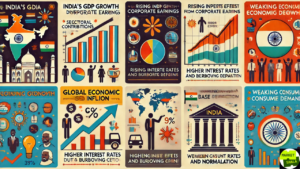Why India’s GDP Growth Isn’t Boosting Corporate Earnings—and What It Means for Investors
India’s GDP is growing at an impressive rate of around 7%, yet corporate earnings are not reflecting the same momentum. This disconnect has left many investors wondering why businesses aren’t seeing proportional gains despite a thriving economy. At a first glance, strong economic growth should translate into better corporate profits, but various underlying factors are creating a divergence.
In this article, we will explore the reasons behind this mismatch, examine the key challenges affecting corporate earnings, and analyze what it means for investors navigating the Indian market. Understanding this complexity can help investors make informed decisions in an evolving economic landscape.
Understanding GDP Growth and Corporate Earnings

- The GDP Growth Paradox Gross Domestic Product (GDP) is a broad measure of a country’s overall economic output. When we see a rise in GDP, it typically indicates economic health, stronger consumption, and improved business activity. For India, GDP growth remains strong, driven largely by a combination of government spending, services, and infrastructure development. However, these growth drivers do not always translate directly into increased profits for individual businesses.
- Corporate Earnings and Stock Market Realities Corporate earnings, especially for publicly traded companies, represent the profitability of individual sectors and industries. The Indian stock market is heavily influenced by certain sectors, like banking, finance, and IT, which can be sensitive to global trends and economic cycles. So, while the GDP reflects broad economic progress, corporate earnings often respond differently based on industry-specific factors.
Key Reasons Behind the GDP Growth and Corporate Earnings Divergence

- Sectoral Contributions: Government and Public Spending Outpaces Private Sector Growth
One significant reason behind the GDP Growth and Corporate Earnings gap is the differing contributions of various sectors to GDP growth. Much of India’s recent growth stems from government spending, particularly in public infrastructure projects. While infrastructure development boosts GDP and creates jobs, private companies—especially those that aren’t directly involved in government contracts—may not see the benefits immediately. Sectors like agriculture, real estate, and informal sectors contribute to GDP but may have minimal impact on the corporate earnings of publicly traded firms.
- Rising Input Costs and Inflation
Inflation has been a persistent issue in India. Higher raw material and input costs make it harder for companies to maintain profitability, even if they experience higher sales. For example, if a company’s revenue increases due to higher product prices (driven by inflation) but their production costs rise at a similar or higher rate, net earnings may suffer. The impact of inflation is particularly felt by industries reliant on imported materials, such as manufacturing and automotive, where rising costs can drastically reduce margins.
- Global Economic Slowdown and Export Dependency
India’s strong GDP growth is primarily domestic, but many of its largest companies have a significant global footprint, especially in sectors like IT services and manufacturing. With the global economy showing signs of a slowdown, demand from foreign markets has weakened. The IT sector, which relies heavily on U.S. and European clients, faces reduced earnings as global clients tighten budgets. This global economic strain directly impacts earnings, even as India’s domestic economy continues to grow.
- Higher Interest Rates and Borrowing Costs
The global rise in interest rates is affecting Indian businesses by making borrowing more expensive. High-interest rates increase the cost of loans, which can reduce profitability for companies that rely on borrowing to fund expansion or operations. Sectors with higher debt levels, such as real estate, infrastructure, and capital-intensive industries, are feeling the pressure from increased financing costs, impacting their overall earnings. The Reserve Bank of India’s monetary policy aimed at controlling inflation indirectly raises borrowing costs for companies, cutting into their bottom line.
- Weakening Consumer Demand
India’s GDP growth does not necessarily indicate strong consumer demand across all sectors and that’s an indicator to the GDP Growth and Corporate Earnings divergence. High inflation has led to reduced disposable incomes, which affects spending on non-essential goods and services. Companies in consumer goods and discretionary spending are seeing slower sales, as consumers prioritize essential purchases. This change in consumer behavior has led to a reduction in earnings, particularly for industries that rely on higher consumer spending, such as retail, lifestyle, and entertainment.
- Pandemic Base Effect and Normalization
Another factor contributing to the perceived contradiction between GDP Growth and Corporate Earnings is the base effect from the pandemic. The Indian economy is now recovering from the lows of the COVID-19 pandemic, making GDP growth rates appear strong due to this low base. Corporate earnings, on the other hand, might have been temporarily boosted by a post-pandemic demand surge, making recent earnings appear lower by comparison.
How This Impacts Investors: The Traps and Opportunities
This divergence between GDP Growth and Corporate Earnings can create a “trap” for investors, especially those assuming that GDP growth automatically translates to a bullish stock market. Here are some implications for investors:

1. Avoid Over-Relying on GDP Growth as a Signal for Stock Performance
GDP growth is often an important indicator, but it is not the only factor that influences corporate earnings or stock prices. While the broader economy may appear strong, investors should conduct sector-specific analyses to understand which industries are positioned to benefit and which may face challenges. For instance, sectors with high exposure to inflationary pressures or global economic conditions may underperform even during periods of GDP growth.
2. Focus on Low-Debt, High-Demand Sectors
With rising interest rates affecting high-debt sectors, investors may want to look for companies with lower debt levels or those in industries with stable demand. Sectors like healthcare, essential consumer goods, and technology services may offer more resilience in the current environment.
3. Reevaluate Export-Oriented Companies
Export-driven companies in India, such as those in the IT or manufacturing sectors, may face headwinds from global economic conditions. Investors should be cautious with firms heavily dependent on international clients and look for companies with a balanced domestic and global revenue stream.
4. Look for Companies Benefiting from Government Spending
Certain sectors, like construction, infrastructure, and energy, stand to benefit directly from government spending. Investing in companies with government contracts or those involved in public projects could be a strategic approach, as these firms may experience a more direct boost from GDP growth.
5. Beware of Valuation Traps
Valuations in the Indian market can be high, especially for companies with perceived growth potential. However, if earnings don’t grow as expected, these valuations may not hold. Investors should keep an eye on earnings reports and consider price-to-earnings ratios and other valuation metrics to avoid overpaying for stocks that may struggle with profitability.
Conclusion: Navigating India’s Complex Economic Landscape
The current scenario, where India’s GDP is growing while corporate earnings decline, highlights the complexity of GDP Growth and Corporate Earnings in the modern financial markets. While it may appear contradictory, a closer look reveals that economic growth and stock market performance are influenced by different, sometimes opposing, forces. Investors need to carefully consider factors like inflation, sectoral dynamics, and global economic trends when making investment decisions. By staying informed and focusing on fundamentals, investors can better navigate these complexities and identify opportunities that align with their financial goals.
This divergence offers both challenges and opportunities, and a thoughtful approach to investing can help avoid potential traps in the Indian market. While a growing GDP is encouraging, understanding the nuances behind the numbers is essential for investors looking to make well-informed decisions.

FAQ: Why India’s GDP Growth Isn’t Boosting Corporate Earnings
Q1: Why aren’t corporate earnings rising with GDP growth?
India’s GDP growth is driven by government spending and infrastructure, but private sector gains lag. Industry-specific issues, like rising costs and global slowdown, also impact earnings.
Q2: How does sector contribution affect earnings?
Government and public spending boost GDP but don’t directly benefit private companies, especially those not linked to public contracts.
Q3: How do inflation and input costs reduce earnings?
Higher production costs due to inflation cut into profits, even when sales rise, particularly in industries reliant on imports.
Q4: Why do global conditions impact Indian companies?
Companies with global exposure, like IT, face reduced demand due to a global economic slowdown, impacting their earnings.
Q5: How do high interest rates affect profitability?
Higher borrowing costs reduce profits for debt-heavy industries, such as real estate and infrastructure.
Q6: What does this mean for investors?
Investors should focus on sectors with low debt, stable demand, or ties to government spending, rather than relying on GDP growth as a signal for stock gains.
Explore More on Markshala
Stay updated with insights on global events, market analysis, and investment strategies on Markshala, where we aim to make financial education accessible and actionable.
Thank you for tuning in to Market-Shala’s Fintalk Dose — your essential source for insights into the financial markets, India and global economy. Now, let’s shift gears and unwind!
Treat yourself to the soothing tunes of MuziMuffin with his latest release available on Spotify, YouTube, Apple Music and Amazon Music. Relax, recharge, and enjoy the vibe!
***********

